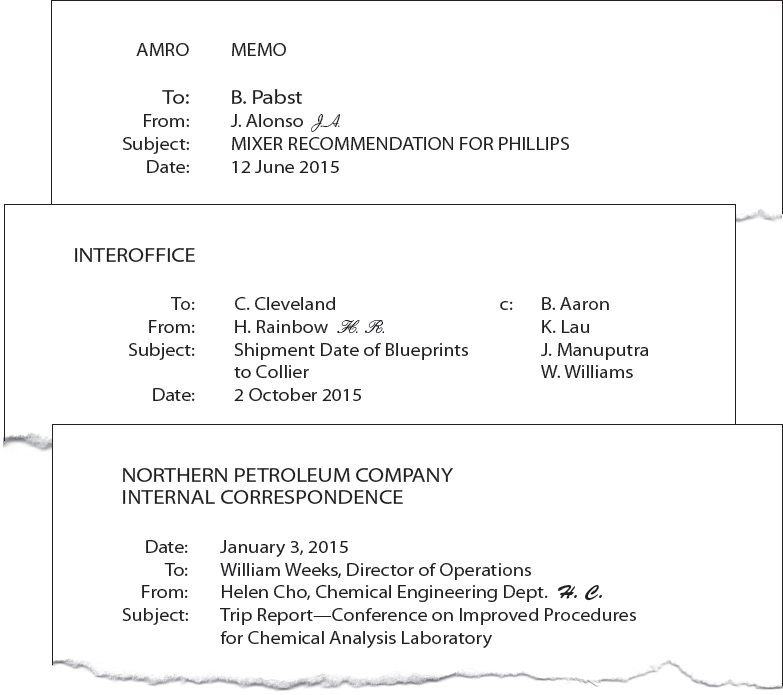Writing Memos
Printed Page 371-374
Writing Memos
Even in the age of email and microblogs, memos are likely to survive because sometimes writers want a slightly more formal document. Like letters, memos have a characteristic format, which consists of the elements shown in Figure 14.10.

Print the second and all subsequent pages of a memo on plain paper rather than on letterhead. Include three items in the upper right-hand or left-hand corner of each subsequent page: the name of the recipient, the date of the memo, and the page number. See the header in Figure 14.3.
Figure 14.11, a sample memo, is a trip report, a record of a business trip written after the employee returned to the office. Readers are less interested in an hour-by-hour narrative of what happened than in a carefully structured discussion of what was important. Although writer and reader appear to be relatively equal in rank, the writer goes to the trouble of organizing the memo to make it easy to read and refer to later.
The subject line is specific: the reader can tell at a glance that the memo reports on a trip to Computer Dynamics, Inc. If the subject line read only “Computer Dynamics, Inc.,” the reader would not know what the writer was going to discuss about that company.
The memo begins with a clear statement of purpose, as discussed in Ch. 5.
Note that the writer has provided a summary, even though the memo is less than a page. The summary gives the writer an opportunity to convey his main request: he would like to meet with the reader.
The main section of the memo is the discussion, which conveys the detailed version of the writer’s message. Often the discussion begins with the background: the facts that readers will need to know to understand the memo. In this case, the background consists of a two-paragraph discussion of the two models in the company’s 500 series. Presumably, the reader already knows why the writer went on the trip.
Note that the writer ends this discussion with a conclusion, or statement of the meaning of the facts. In this case, the writer’s conclusion is that the company should consider only the external drive.
A recommendation is the writer’s statement of what he would like the reader to do next. In this case, the writer would like to sit down with the reader to discuss how to proceed.

Organizing a Memo

When you write a memo, organize it so that it is easy to follow. Consider these five organizational elements.
- A specific subject line. “Breast Cancer Walk” is too general. “Breast Cancer Walk Rescheduled to May 14” is better.
- A clear statement of purpose. As discussed in Chapter 5, "Determining Your Purpose," the purpose statement is built around a verb that clearly states what you want the readers to know, believe, or do.
- A brief summary. Even if a memo fits on one page, consider including a summary. For readers who want to read the whole memo, the summary is an advance organizer; for readers in a hurry, reading the summary substitutes for reading the whole memo.
- Informative headings. Headings make the memo easier to read by enabling readers to skip sections they don’t need and by helping them understand what each section is about. In addition, headings make the memo easier to write because they prompt the writer to provide the kind of information readers need.
- A prominent recommendation. Many memos end with one or more recommendations. Sometimes these recommendations take the form of action steps: bulleted or numbered lists of what the writer will do or what the writer would like others to do. Here is an example:
Action Items:
I would appreciate it if you would work on the following tasks and have your results ready for the meeting on Monday, June 9.
- Henderson: recalculate the flow rate.
- Smith: set up meeting with the regional EPA representative for some time during the week of May 13.
- Falvey: ask Armitra in Houston for his advice.